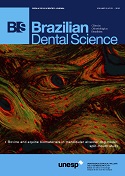Influence of the interocclusal splint in condylar position of patients with tmd: computed cone beam
DOI:
https://doi.org/10.14295/bds.2016.v19i3.1264Abstract
The aim of this study was to evaluate the condylar position in patients with intra-articular temporomandibular disorders (TMD) before and after treatment with interocclusal stabilization splint (ISS) through computerized tomography cone beams (CTCB). Twenty-two patients diagnosed with intra-articular TMD (Research Diagnostic Criteria for Temporomandibular Disorders - Group II) were submitted to the therapy with ISS during 90 days. Three CTCB exams were performed in three moments: T1 – Initial moment, before the ISS therapy, with the patient in dental occlusion; T2 (after 90 days of treatment, in occlusion on the ISS) and T3 (after 90 days of treatment, with the patient in dental occlusion). Afterwards the anterior (AS), superior (SS) and posterior articular space (PS) in sagittal sections were then measured and the data were statistically analyzed using the t-test. There was a statistically significant increase in the comparison between T1 and T2 for the AS and PS (p< 0.0001), between T3 and T2 for AS (p= 0.0008) and PS (p< 0.0001). In comparison T1/T3 there was a significant increase in AS (p= 0.01) and SS (p= 0.04), and non-significant in PS (p= 0.89). The interocclusal splint provides temporary changes in condylar position, with a tendency to increase the joint space, varying in accordance with individual characteristics. Therefore, it should not be used as a single therapy, but combined with other strategies that include the TMD multidimensionality. The interocclusal splint has proved to be reversible and conservative therapeutic modality, as it does not generate permanent changes in joint tissues.Downloads
Downloads
Additional Files
Published
How to Cite
Issue
Section
License
Brazilian Dental Science uses the Creative Commons (CC-BY 4.0) license, thus preserving the integrity of articles in an open access environment. The journal allows the author to retain publishing rights without restrictions.
=================




























